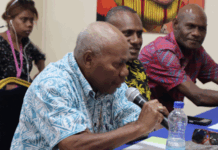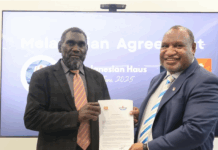
By Ivy Mallam of Wansolwara
Media professionals have been urged to undergo gender sensitisation training to produce more inclusive, accurate and ethical representation of women in the news.
Fiji Women’s Rights Movement executive director Nalini Singh emphasised that such training would help avoid reinforcing harmful stereotypes and promote diverse perspectives, ensuring media coverage reflects the realities of all genders.
She made these comments during her keynote address at a panel discussion on “Gender and Media in Fiji and the Pacific” at the 2024 Pacific International Media Conference at the Suva Holiday Inn in Fiji on July 4-6.
In her presentation, Singh highlighted the highest rates of gender violence and other forms of discrimination against women in the region.
She said the Pacific region had, among the highest rates of gender-based violence in the world, with ongoing efforts to provide protection mechanisms and work towards prevention.

She highlighted that women in Fiji and the Pacific carried a disproportionate burden of unpaid care work, spending approximately three times as much time on domestic chores and caregiving as men.
This limits their opportunities for income-generating activities and personal development.
Labour participation low
According to Singh, women’s labour force participation remains low — 34 percent in Samoa and 84 percent in the Solomon Islands. The underemployment of women restricts economic growth and perpetuates income inequality, leaving families with single earners, often males with less financial stability.
She highlighted that women were significantly underrepresented in leadership positions as well. In Fiji, women held only 21 percent of board seats, 11 percent of board chairperson roles, and 30 percent of chief executive officer positions.
Despite numerous commitments from the United Nations and other bodies over past decades, including the Beijing Platform for Action and the Convention on the Elimination of All Forms of Discrimination against Women (CEDAW), Singh pointed out that gender equality remained a distant goal.
The World Economic Forum estimates that closing the overall gender gap will take 131 years, with economic parity taking 169 years and political parity taking 162 years at the current rate of progress.
Singh shared that women were more negatively impacted on by climate change due to limited access to resources and information, adding that media often depicted women as caregivers and community leaders during climate-related disasters, highlighting their increased burdens and risks.
The efforts made by FWRM in addressing sexual harassment in the workplace was also highlighted at the conference, with a major reference to the research and advocacy by the organisation that has contributed to policy changes that include sexual harassment as a cause for disciplinary action under employment regulations.

Singh challenged the conference attendees to prioritise creating safer workplaces for women in media. She urged academics, media organisations, students, and funders to take concrete actions to stop sexual harassment and gender-based violence.
“We must commit to fostering workplaces and online platforms where everyone feels safe and respected.
‘Free from fear’
“Together, we can create environments free from fear and discrimination. Enough is enough,” Singh urged, emphasising the need for collective commitment and action from all stakeholders.
The conference, the first of its kind in 20 years, was organised by The University of the South Pacific’s Journalism Programme in collaboration with the Pacific Islands News Association and the Asia Pacific Media Network.
It was officially opened by chief guest Deputy Prime Minister of Fiji and the Minister for Trade, Co-operatives, Small and Medium Enterprises and Communications Manoa Kamikamica.
Kamikamica said the Fijian government stood firm in its commitment to safeguarding media freedom, as evidenced by recent strides such as the repeal of restrictive media laws and the revitalisation of the Fiji Media Council.
Papua New Guinea Minister for Communication and Information Technology Timothy Masiu was also present at the official dinner of the conference on July 4.

He said the conference theme “Navigating Challenges and Shaping Futures in Pacific Media Research and Practice” was appropriate and timely.
“If anything, it reminds us all of the critical role that the media continues to play in shaping public discourse and catalysing action on issues affecting our Pacific.”
Launch of PJR
The official dinner included the launch of the 30th anniversary edition of the Pacific Journalism Review (PJR) and launch of the book Waves of Change: Media, Peace, and Development in the Pacific, which is edited by the Associate Professor Shailendra Singh, Deputy Prime Minister and Minister for Finance Professor Biman Prasad and Dr Amit Sarwal, a former senior lecturer and deputy head of school (research) at USP.
The PJR is the only academic journal in the region that publishes research specifically focused on Pacific media.
The conference was sponsored the US Embassy in Fiji, Kiribati, Nauru, Tonga and Tuvalu, the International Fund for Public Interest Media, the Pacific Media Assistance Scheme, Fiji Women’s Rights Movement, New Zealand Science Media Centre and the Pacific Women Lead – Pacific Community.
With more than 100 attendees from 11 countries, including 50 presenters, the conference provided a platform for discussions on issues and the future.
The core issues that were raised included media freedom, media capacity building through training and financial support, the need for more research in Pacific media, especially in media and gender, and some other core areas, and challenges facing the media sector in the region, especially in the wake of the digital disruption and the covid-19 pandemic.
Ivy Mallam is a final-year student journalist at The University of the South Pacific, Laucala Campus. Republished in collaboration with Wansolwara.













































